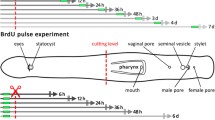Summary
Following transection ofDileptus regulation of cell shape and cortical pattern was studied during regeneration in an attempt to understand the interrelations of these two regulation processes. The cell ofDileptus consists of two regions, proboscis and trunk, with the oral structures marking the border between them. The isolated proboscis is able to reorganize into a complete and correctly proportioned organism and the course of this reorganisation has been observed.
Correct cell proportions take more than 24h to be established. Three hours after the operation the new border between proboscis and trunk is formed. Initially, the proportions of the cell are far from normal; moreover, they can temporarily change towards a more abnormal state. This indicates that the localisation of the border between the two cell regions and the assessment of final cell proportions are separate phenomena possibly controlled by different mechanisms.
Similar content being viewed by others
References
Corliss, J.O.: Remarks on the composition of the large ciliate class Kinetofragmophora de Puytorac et al., 1974, and recognition of several new taxa therein, with emphasis on the primitive order Primociliatida N. Ord. J. Protozool.21, 207–220 (1974)
Doerder, F.P., Frankel, J., Jenkins, L.M., DeBault, L.E.: Form and pattern in ciliated protozoa: analysis of a genic mutant with altered shape inTetrahymena pyriformis, syngen 1. J. Exp. Zool.192, 237–258 (1975)
Frankel, J.: Positional information in unicellular organisms. J. Theor. Biol.47, 439–481 (1974)
Frankel, J.: An analysis of cell-surface patterning in Tetrahymena. In: Determinants of spatial organisation (S. Subtelny, ed.), pp. 215–246 New York: Academic Press 1979
Gierer, A., Meinhardt, H.: A theory of biological pattern formation. Kybernetik12, 30–39 (1972)
Golinska, K.: Effect of puromycin on regeneration processes inDileptus anatinus Golinska 1971. Acta Protozool.12, 289–306 (1974)
Golinska, K.: The course of in situ remodelling of injured mouthparts inDileptus (Ciliata, Gymnostomata). Acta Protozool.17, 47–67 (1978)
Golinska, K., Jerka-Dziadosz, M.: The relationship between cell size and capacity for division inDileptus anser andUrostyla cristata. Acta Protozool.12, 1–21 (1973)
Golinska, K., Kink, J.: The regrowth of oral structures inDileptus cygnus after partial excision. Acta Protozool.15, 143–163 (1976)
Golinska, K., Kink, J.: Proportional regulation of body form and cortical organelle pattern in the ciliateDileptus. J. Cell Sci.24, 11–29 (1977)
Grain, J., Golinska, K.: Structure et ultrastructure deDileptus cygnus Claparède et Lachmann, 1859, Cilié Holotriche Gymnostome. Protistologica5, 269–291 (1969)
Hicklin, J., Hornbruch, A., Wolpert, L., Clarke, M.: Positional information and pattern regulation in hydra: the formation of boundary regions following axial grafts. J. Embryol. Exp. Morphol.30, 701–725 (1973)
Jerka-Dziadosz, M., Golinska, K.: Regulation of ciliary pattern in ciliates. J. Protozool.16, 612–637 (1977)
Kink, J.: A localised region of proliferation in growing cells ofDileptus visscheri (Ciliata, Gymnostomata). J. Cell Sci.20, 115–133 (1976)
McMahon, D., West, C.: Transduction of positional information during development. In: The cell surface in animal embryogenesis and development (G. Poste, G.I. Nicolson, eds.), pp. 449–493. Amsterdam. Elsevier/North Holland Biomedical Press 1976
Meinhardt, H., Gierer, A.: Applications of a theory of biological pattern formation based on lateral inhibition. J. Cell Sci.15, 321–346 (1974)
Nanney, D.L.: Cortical integration inTetrahymena: an exercise in cytogeometry. J. Exp. Zool.161, 307–317 (1966)
Terra, N. de: Leucine incorporation into the membranellar bands of regenerating and nonregeneratingStentor. Science153, 543–544 (1966)
Wolpert, L.: The French Flag problem: a contribution to the discussion on pattern development and regulation. Towards a Theoretical Biology1, 125–133 (1968)
Wolpert, L.: Positional information and pattern formation. Curr. Top. Dev. Biol.6, 183–224 (1971).
Author information
Authors and Affiliations
Rights and permissions
About this article
Cite this article
Golinska, K. Assessment of cell proportions during regeneration ofDileptus anser (Ciliata). Wilhelm Roux' Archiv 187, 307–321 (1979). https://doi.org/10.1007/BF00848466
Received:
Accepted:
Issue Date:
DOI: https://doi.org/10.1007/BF00848466



